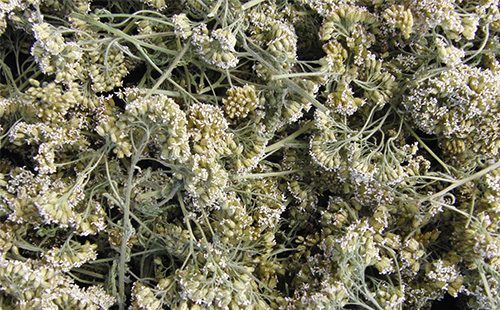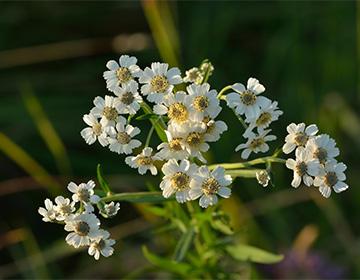The content of the article
The Latin name of the culture Achillea millefolium is associated with the name of the hero of the Trojan War Achilles. According to legend, the famous warrior applied the leaves of the plant to the wounds of his fighters, and even extensive damage on their bodies quickly healed. The species definition of millefolium literally translates as "a thousand leaves", which gave the name to the medicinal plant in Russian.
Botanical characteristic
A plant of the Asteraceae family is widespread in Russia. Perhaps there is no region where no single stalks, covered with many tiny leaves, or large natural populations are found. Despite the traditional application of culture in scientific and folk medicine, artificial plantings of grass do not produce.
And the point is not only in the availability of raw materials in the wild, but in the fact that the yarrow grown on specialized plantations is losing its medicinal properties. Why this happens is a mystery to science.
Description
The herbaceous culture is perennial, grows and bears fruit for three to five years, after which it dies. It has a thick, creeping rhizome with multiple adventitious roots that do not give the stalk resistance. It easily breaks out of the ground with careless movement, due to which natural planting is severely damaged when harvesting raw materials by hand, without a cutting tool.
The height of the stems is on average 50 cm. But there are smaller stems up to 20 cm tall, as well as real giants - more than 1 m. The stems are always straight, with angular grooves, smooth or slightly pubescent with thin whitish hairs. In the upper part, the stem branches, and each shoot forms a flowering head. Because of this, during flowering, it seems that a thin stalk literally bends under the weight of the flowering hat.
The plant gained its characteristic appearance thanks to its multiple dissected leaves, with elongated elements resembling thin needles. They develop from the basal rosette, reaching a length of 15 cm. Their surface is gray-green, on the reverse side - with noticeable oil veins. In height, the stem produces smaller leaves.
Since July, during the flowering period, the grass looks amazing. Covered with white (sometimes pinkish or lilac) flowers, it resembles baskets with porridge. Hence the popular name "white porridge". Inflorescences are collected in shields up to 15 cm in diameter, and the plant retains such decoration until September. Only in the autumn does it form seeds-seeds, which randomly crumble to the ground.
Collection and harvesting of raw materials
Natural plantings are identified in dry meadows, along roads, on the outskirts of fields, close to summer cottages, in shrubbery. It is not possible to indicate the exact areas of the plant — yarrow is ubiquitous.
Flowers and grass of a culture possess medicinal value; they are harvested at different times.
- Flowers. Only flower baskets are harvested, cutting the stem as high as possible. The length of the legs in the finished raw materials should be no more than 4 cm. Dried under awnings or in the shade, in well-ventilated areas.
- Leaves. The collection is carried out before flowering, when the lower basal leaves are best developed. Cut with scissors, dried in the same way as flowers. There should be no admixtures of stems and flower baskets in the finished raw materials.
Composition
The healing properties of the plant are determined by the content of a complex of biologically active substances in its composition.
The leaves revealed:
- vitamin K;
- achillein;
- essential oil:
- organic acids (acetic, formic, isovalerianic);
- flavanoids.
Vitamin K and Achillein directly affect the hematopoiesis system and blood coagulation. The first increases the amount of prothrombin, accelerates the formation of blood clots during bleeding. The second - increases the number of platelets.
The plant ether differs in the content of chamazulen (an inflammation blocker), borneol, camphor, thujone, cineole. Due to this, the yarrow has a pronounced anti-inflammatory activity, which is ahead of many well-known herbs.
The flowers also contain essential oil, the concentration of which reaches 0.8% with properties similar to leaves. In addition, identified:
- sesquiterpenes;
- flavonoids;
- tannins;
- coumarins;
- tannins.
Properties
Traditionally, the plant was attributed hemostatic, anti-inflammatory and choleretic action. Thanks to studies in recent years, this list has been able to expand with no less significant pharmacological effects.
- Antimicrobial. High activity of the medicinal plant (even at the minimum dosage) against the bacterium Helicobacter pylori was revealed. This made it possible to scientifically substantiate popular practices on the use of yarrow in the treatment of diseases of the stomach (gastritis, ulcer), to stimulate appetite (if its absence is associated with gastrointestinal disorders). The ability to inhibit the growth of Shigella bacteria has also been established, but the culture has no effect on Escherichia coli and Salmonella.
- Anticonvulsant. This effect was specified in an experiment with an alcoholic extract in rats. The introduction of the drug relieved an attack of seizures, convulsions caused by a chemical agent. The experimental results also justify the use of the plant as a mild sedative with a slight hypotensive effect.
- Antioxidant. This property causes chamazulen, which suppresses lipid peroxidation of cell membranes. So, the plant supports the body in acute and chronic inflammation, prevents the accumulation of free radicals in the tissues.
- Antipyretic. It was experimentally established that an aqueous infusion of a plant lowers the temperature when taken orally. Alcohol extract does not have this ability.
- Antispasmodic. It manifests itself with spasm of the digestive system (intestines, stomach).
The ability of the plant to stimulate the production of gastric juice is also noted. It was identified by administering an alcoholic flower extract to healthy volunteers. This means that the use of herbal medicine is relevant for gastritis, ulcer, colitis, accompanied by a decrease in the secretion of gastric juice or its acidity.

Therapeutic practice
Herbal remedies are included in the treatment of diseases of three types.
- Bleeding. “In diseases associated with internal and external bleeding, yarrow is simply necessary,” said phytotherapist A. Varennikov. “Unlike nettles, highlander and other hemostatic herbs, you can take it for a long time without the risk of provoking varicose veins.” Dosage forms of the plant are used for minor bleeding from the nose, gums, wounds, scratches, abrasions. Assign with hemorrhoids, internal pulmonary hemorrhage. Used in gynecology, when the underlying disease causes uncontrolled loss of blood (uterine, fibromyoma). It is allowed to use grass to normalize heavy periods. But it is important to consider that traditional medicine refers the plant to monthly, that is, accelerating the arrival of menstruation in violation of the cycle.
- Gastrointestinal diseases. The plant has the widest spectrum of action on the digestive system, so herbalists include it in all fees intended for the treatment of gastrointestinal diseases.
- Urinary tract inflammation. Yarrow is traditionally included in the fees for the treatment of cystitis, helps to cope with the infection, relieves pain during urination.
Prescription Drugs
In folk medicine, a phytopreparation is used even more widely. Herbalist, phytotherapist M. Nosal recommended using a pair of flowers in combination with chamomile for face care. Herbalist A. Varennikov advises rinsing the throat with a decoction of the plant for colds, notes the value of the culture in sedative collections for bradycardia, neurasthenia, hysteria.
Water infusion
Features. In its pure form, a medicinal plant is used to stop bleeding (uterine, with myoma, hemoptysis). Also used to improve appetite for violations of the digestive tract, nervous strain, stress.
How to make and apply
- Pour a tablespoon in a thermos with a slide of dried leaf.
- Pour boiling water with a volume of 500 ml.
- Cork, leave for 30 minutes.
- Take three to four times a day in a glass, do not mix with food. Before eating, you should drink the infusion for half an hour, after eating - an hour. If the product is intended to stimulate appetite, take immediately before a meal.
Combined broth
Features. An effective treatment for inflammatory diseases of the urinary system. Relieves pain, relieves symptoms.
How to make and apply
- Combine two tablespoons of yarrow, bearberry.
- Add a tablespoon of calamus root and birch buds.
- Take two tablespoons of the mixture, pour into an enameled container.
- Pour boiling water with a volume of 600 ml.
- Put on fire, bring to a boil.
- Rinse for seven minutes.
- Leave to infuse for 30 minutes.
- Strain.
- The resulting mixture should be drunk within one day, divided into four doses.
Antispasmodic infusion
Features. It is used for severe pain in the stomach caused by spasm.
How to make and apply
- Mix a tablespoon of yarrow and chamomile.
- Pour boiling water with a volume of 250 ml.
- Leave to infuse for 30 minutes.
- Take the product warm before meals.To release the spasm faster, put a heating pad on the stomach area.
Topar for external use
Features. Phytotherapist M. Nosal recommends a tool for young women to wash and rub their faces to cleanse the skin, give it velvety, dullness.
How to make and apply
- Mix two tablespoons of yarrow with one tablespoon of chamomile.
- Pour boiling water with a volume of 250 ml.
- Leave to infuse for 30 minutes.
- Strain.
- Wipe your skin in the morning and evening instead of tonic.
The juice
Features. Fresh plant juice promotes wound healing. It is effective for fresh injuries: it stops bleeding, prevents suppuration. He cleans up old ones from pus, heals ulcers and boils. Travnik N. Maznev advises taking the drug inside as a hemostatic, as well as for general strengthening of the body and in liver diseases.
How to make and apply
- Twist the fresh leaves of the plant in a meat grinder.
- Squeeze the juice through cheesecloth.
- Mix with honey in a 1: 1 ratio.
- Take the composition three times a day for a tablespoon.

Contraindications
Traditional medicine considers the plant to be universal and safe. But culture still has contraindications - the relevant data are provided by the World Health Organization. Grass cannot be used for:
- individual intolerance to plants of the family Asteraceae;
- contact dermatitis;
- hypersensitivity of the skin and mucous membranes;
- bile duct occlusion;
- gallbladder disease;
- pregnancy.
There is a practice of using a plant for weight loss, but it is not supported scientifically or by the opinion of nutritionists. It is believed that herbal tea helps accelerate the breakdown of fats and expels excess water from the body. Indeed, culture has a general strengthening effect, stabilizes metabolism, and saves from edema, but does not directly affect fat masses. To use a plant with a set of therapeutic effects for weight loss is erroneous and dangerous.

